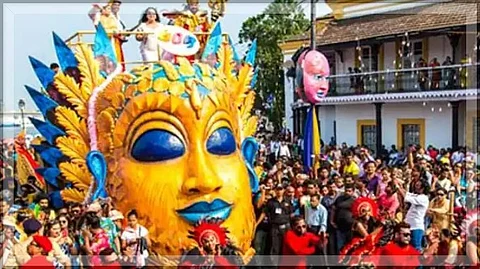

The Goan Carnival, a festival with roots in Portuguese colonial history, is one of the most anticipated events in the region’s cultural calendar. This year, it will kick off on the weekend before Ash Wednesday, signaling the start of a four-day celebration that blends Goan traditions with influences from around the world. The carnival is held in various towns and villages across the state, with the heart of the celebration centered around Panjim, the capital city.
As the days leading up to the carnival approach, the streets of Goa start to come alive. Shops decorate their windows with colorful masks, feathers, and lights. The vibrant costumes and accessories are being put together, and the smell of festive food fills the air. The Goan Carnival is known for its larger-than-life parades featuring beautifully decorated floats, traditional Goan music, and the beats of the famous Carnival drummers. People of all ages are busy preparing for the ultimate celebration of life, love, and music.
The atmosphere is electric as the first day of the carnival dawns. It all begins with a grand parade, where locals and tourists alike gather along the streets to watch the colorful floats and dancers pass by. These floats often depict scenes from Goan folklore, mythological tales, or satire on current events, and are intricately designed by local communities. The parades are not just a spectacle to behold but a celebration of community spirit, creativity, and culture.
Traditional Goan music plays an essential role during the carnival. The energetic rhythm of the traditional 'dhol' (drum), accompanied by the lively beats of 'tashas' (Goan brass bands), fills the air as people move through the streets. The sounds are infectious, urging everyone—locals and tourists alike—to join the dance. The streets are filled with revelers dressed in an array of bright costumes, from fantastical creatures to characters from folklore, each person eager to partake in the fun. There’s a sense of freedom as the costumes symbolize the carnival’s theme of shedding inhibitions and celebrating life in all its vibrant hues.
The carnival isn't only about parades and music; it’s also about indulging in food and drink. Carnival-goers line the streets, enjoying these savory and sweet treats while sharing laughter and stories. The taste of feni, Goa’s famous cashew spirit, also flows freely, adding to the festive atmosphere.
In the evenings, the carnival celebrations shift to the stage with vibrant performances and live music. Local and international artists take to the stage, showcasing everything from folk dances to modern-day performances, as the crowd sings, dances, and celebrates late into the night. The streets of Goa come alive, and there’s no shortage of dancing, singing, and revelry. Families, friends, and strangers unite as they enjoy the carnival together, embodying the true spirit of Goa’s rich cultural heritage.
One of the most iconic aspects of the Goan Carnival is the character of King Momo, the symbolic ruler of the festivities. According to tradition, King Momo is crowned at the beginning of the carnival, and he’s often a local personality or celebrity who leads the parade and gives a speech full of humor and wit. His character represents the exuberance and joy of the carnival, and he plays a key role in ensuring the festivities are filled with laughter and happiness.
The Goan Carnival is much more than just a series of parades and parties; it’s a time for the entire community to come together, to celebrate life, to enjoy good food, music, and dance, and to forget their worries. It’s a beautiful blend of tradition and modernity, where Goa’s colonial past meets the spirit of the modern-day world. As this year’s carnival approaches, there’s a sense of anticipation in the air, with people eagerly awaiting the festivities and the opportunity to be part of a truly unforgettable celebration of Goan culture and life.